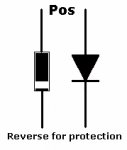- Joined
- Jul 7, 2007
- Messages
- 492
- Points
- 0
ok i have 2 questions
1. what is the polarity of these refractor diodes? does the ring represent the + or the -
http://www.diodes.com/datasheets/ds28002.pdf
and 2 deadel when you built the blu-ray circut did you put the diode in sequence or parallel with the LD to get rid of some of the voltage?
thanks alot in advance,
Mitch
1. what is the polarity of these refractor diodes? does the ring represent the + or the -
http://www.diodes.com/datasheets/ds28002.pdf
and 2 deadel when you built the blu-ray circut did you put the diode in sequence or parallel with the LD to get rid of some of the voltage?
thanks alot in advance,
Mitch






